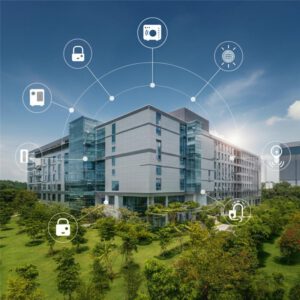What is a Building Management System (BMS)? Key Functions, Benefits, and How It Optimizes Commercial Buildings
What is it that separates a “smart building” from a regular building (we’ll refrain from calling them “dumb buildings”)? Smart commercial buildings respond to their tenants, operators, ambient weather, electrical grid supply, occupant safety, and uptime conditions. The technology driving this responsiveness is the Building Management System (BMS). Whether it’s controlling energy use, adjusting HVAC operations, ensuring access to cloud-hosted applications running in data centers, or monitoring security, a BMS serves as the central brain of modern facilities.
This article breaks down what a BMS is, explores its core functions, and highlights how open, scalable BMS solutions boost efficiency, reduce costs, and reach sustainability goals.
What is a Building Management System (BMS)?
A Building Management System (BMS) is a centralized digital platform that connects, monitors, and automates a building’s mechanical and electrical systems—like HVAC, lighting, energy metering, and security. BMS and BAS (Building Automation System) are used interchangeably.
By providing real-time visibility into how these systems perform, a BMS empowers facility teams to control building functions proactively. It enables operators to optimize energy usage, reduce downtime, and maintain occupant comfort, all from a single interface.
Unlike legacy controls that operate in silos, a BMS acts as the facility’s command center—bringing automation, insight, and intelligence to day-to-day operations.
How Does a BMS Centralize Building Functions?
Traditional buildings often run operational systems independently. Lighting, HVAC, fire safety, and access control may each have their own interface, creating data silos and missed optimization opportunities. For instance, a building that is only occupied for part of the day but keeps their lighting and HVAC running during those low occupancy hours is simply wasting money and energy. But with all their data in silos, separated from one another, it takes more time and effort to mitigate those losses. A BMS increases the efficiency of the entire operation.
A BMS breaks down those silos by integrating systems into a unified network using open communication protocols like BACnet. This allows:
- Cross-system coordination (e.g., lights dimming when HVAC ramps down)
- Unified scheduling and control
- Real-time alerts for any part of the facility
KMC’s solutions are built with this integration in mind—helping facility teams manage all building systems cohesively while scaling across campuses or portfolios.
What Are the Core Functions of a BMS?
Here’s how a BMS empowers commercial buildings through centralized automation:
Energy Efficiency
Track real-time consumption, identify inefficiencies, and generate actionable insights. A BMS can detect if HVAC is running in unoccupied zones or simultaneously heating and cooling, then adjust accordingly—cutting unnecessary load and costs.
The best energy tools support dynamic visualization, fault detection, and load profiling to help managers fine-tune system performance.
HVAC Control
One of the largest energy drains in any facility, HVAC is best managed by automation. According to the EIA, HVAC accounts for 5-15% of total US electricity consumption. A BMS can:
- Adjust temperatures based on occupancy or outside weather
- Optimize airflow and zoning
- Monitor air quality and ventilation needs
These features improve both efficiency and occupant wellness.
Lighting Management
Lighting systems integrated with a BMS respond to occupancy, daylight levels, and building schedules. Automating this reduces both electricity costs and maintenance needs, while improving safety and comfort for occupants.
The best solutions allow lighting to be scheduled or set to “adaptive” modes that respond to real-time use and environmental conditions.
Security Integration
A BMS can connect with access control systems, intrusion detection, and emergency alerts. It centralizes visibility and ensures faster response times while enhancing occupant safety.
The best platforms support security features that scale with the unique demands of healthcare, education, retail, and more.
What Are the Key Benefits of a BMS?
✅ Operational Efficiency
With intelligent scheduling and automation, a BMS eliminates the need for manual adjustments. Predictive maintenance and system diagnostics ensure smooth performance and reduce downtime.
✅ Cost Savings
By optimizing energy and system runtimes, a BMS helps cut utility bills and extends equipment life. It also reduces labor and maintenance costs by automating repetitive tasks.
✅ Sustainability & Compliance
A BMS supports LEED, ENERGY STAR, and local efficiency benchmarks by reducing energy use and automating data collection for regulatory compliance.
Why Choose KMC Controls’ BMS Solutions?
KMC Controls is a leader in flexible, open-protocol building management platforms. Whether you’re operating a hospital, a school, or a commercial building, KMC provides:
- Customizable Dashboards
Tailored views and tools for every facility type - Seamless Integration with BAS & IoT
Unified control across HVAC, lighting, metering, and security - Scalable Architecture
Suitable for single buildings or large portfolios - Local and Remote Access
Control and monitor systems from anywhere, any time
With decades of experience in building automation, KMC is known for intuitive interfaces, reliable performance, and open standards that future-proof your investment.
Final Thoughts
A Building Management System isn’t just about managing systems or making a more responsive building, although those are both true. It’s about doing things with excellence. From energy savings to streamlined operations and increasing occupant safety, a BMS offers high-impact improvements across every square foot.
KMC Controls offers more than just an operating platform – we are a partner in performance for our certified installers and their clients, for the life cycle of their building.
Not only do we provide the systems necessary, but we will train you in how to use them and be a resource for future needs should they arise. Discover how our customizable BMS solutions are helping facility managers modernize, optimize, and future-proof their buildings.

 Cart
Cart
